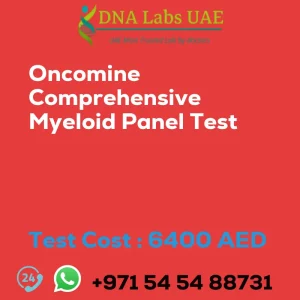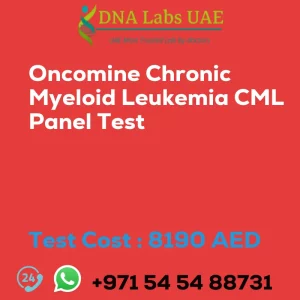IMMUNOHISTOCHEMISTRY PROLACTIN Test
Test Name: IMMUNOHISTOCHEMISTRY PROLACTIN Test
Components: Prolactin Test
Price: 410.0 AED
Sample Condition: Submit tumor tissue in 10% Formal-saline OR Formalin fixed paraffin embedded block. Ship at room temperature. Provide a copy of the Histopathology report, Site of biopsy and Clinical history.
Report Delivery: Sample Daily by 6 pm; Report Block: 5 days Tissue Biopsy: 5 days Tissue large complex: 7 days
Method: Immunohistochemistry
Test type: Cancer
Doctor: Oncologist, Pathologist
Test Department: Pre Test Information
Pre Test Information: Provide a copy of the Histopathology report, Site of biopsy and Clinical history.
Test Details:
Immunohistochemistry (IHC) is a technique used to detect specific proteins in tissue samples. In the case of the prolactin test, IHC can be used to identify the presence and distribution of prolactin in a tissue sample. To perform an immunohistochemistry prolactin test, the following steps are typically followed:
- Tissue fixation: The tissue sample is collected and fixed using a suitable fixative, such as formalin. This helps preserve the tissue structure and proteins.
- Tissue processing: The fixed tissue is then processed by embedding it in paraffin wax, which allows for easier handling and sectioning.
- Sectioning: Thin sections (usually around 4-6 micrometers) of the paraffin-embedded tissue are cut using a microtome. These sections are then mounted onto glass slides.
- Deparaffinization: The paraffin wax is removed from the tissue sections using a series of xylene or other organic solvent washes.
- Antigen retrieval: To expose the prolactin protein for antibody binding, antigen retrieval is performed. This can be done by heating the tissue sections in a buffer solution or using enzymatic digestion.
- Blocking: Non-specific binding sites on the tissue sections are blocked using a blocking agent, such as bovine serum albumin or normal serum.
- Primary antibody incubation: The tissue sections are incubated with a primary antibody specific to prolactin. This antibody will bind to the prolactin protein if present in the tissue.
- Secondary antibody incubation: After washing off unbound primary antibody, a secondary antibody is applied. This secondary antibody is conjugated to a detection system, such as an enzyme or fluorophore.
- Visualization: The detection system on the secondary antibody reacts with a substrate, resulting in a visible signal. This signal can be visualized under a microscope or using other imaging techniques.
- Counterstaining: To enhance tissue contrast and provide additional information, a counterstain may be applied to the tissue sections. Hematoxylin is commonly used as a counterstain.
- Analysis: The tissue sections are examined under a microscope, and the presence and distribution of prolactin in the tissue sample are evaluated. This analysis can help diagnose prolactin-related conditions or study the role of prolactin in various tissues.
It is important to note that the specific protocol and reagents used for the immunohistochemistry prolactin test may vary depending on the laboratory and specific requirements of the study or diagnostic evaluation.
| Test Name | IMMUNOHISTOCHEMISTRY PROLACTIN Test |
|---|---|
| Components | |
| Price | 410.0 AED |
| Sample Condition | Submit tumor tissue in 10% Formal-saline OR Formalin fixed paraffin embedded block. Ship at room temperature. Provide a copy of the Histopathology report, Site of biopsy and Clinical history. |
| Report Delivery | Sample Daily by 6 pm; Report Block: 5 days Tissue Biopsy: 5 days Tissue large complex : 7 days |
| Method | Immunohistochemistry |
| Test type | Cancer |
| Doctor | Oncologist, Pathologist |
| Test Department: | |
| Pre Test Information | Provide a copy of the Histopathology report, Site of biopsy and Clinical history. |
| Test Details |
Immunohistochemistry (IHC) is a technique used to detect specific proteins in tissue samples. In the case of the prolactin test, IHC can be used to identify the presence and distribution of prolactin in a tissue sample. To perform an immunohistochemistry prolactin test, the following steps are typically followed: 1. Tissue fixation: The tissue sample is collected and fixed using a suitable fixative, such as formalin. This helps preserve the tissue structure and proteins. 2. Tissue processing: The fixed tissue is then processed by embedding it in paraffin wax, which allows for easier handling and sectioning. 3. Sectioning: Thin sections (usually around 4-6 micrometers) of the paraffin-embedded tissue are cut using a microtome. These sections are then mounted onto glass slides. 4. Deparaffinization: The paraffin wax is removed from the tissue sections using a series of xylene or other organic solvent washes. 5. Antigen retrieval: To expose the prolactin protein for antibody binding, antigen retrieval is performed. This can be done by heating the tissue sections in a buffer solution or using enzymatic digestion. 6. Blocking: Non-specific binding sites on the tissue sections are blocked using a blocking agent, such as bovine serum albumin or normal serum. 7. Primary antibody incubation: The tissue sections are incubated with a primary antibody specific to prolactin. This antibody will bind to the prolactin protein if present in the tissue. 8. Secondary antibody incubation: After washing off unbound primary antibody, a secondary antibody is applied. This secondary antibody is conjugated to a detection system, such as an enzyme or fluorophore. 9. Visualization: The detection system on the secondary antibody reacts with a substrate, resulting in a visible signal. This signal can be visualized under a microscope or using other imaging techniques. 10. Counterstaining: To enhance tissue contrast and provide additional information, a counterstain may be applied to the tissue sections. Hematoxylin is commonly used as a counterstain. 11. Analysis: The tissue sections are examined under a microscope, and the presence and distribution of prolactin in the tissue sample are evaluated. This analysis can help diagnose prolactin-related conditions or study the role of prolactin in various tissues. It is important to note that the specific protocol and reagents used for the immunohistochemistry prolactin test may vary depending on the laboratory and specific requirements of the study or diagnostic evaluation. |







